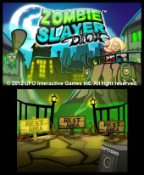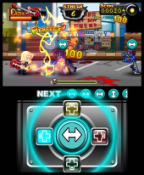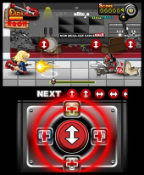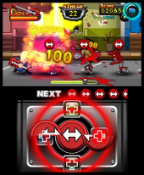Zombie Slayer Diox Review
|
|
See PixlBit's Review Policies

On 04/02/2012 at 05:07 PM by Angelo Grant Portability, accessibility and affordability do not excuse mediocrity. |

Only for those obsessed with the rhythm game genre with nothing else to play.
I’ve read countless reviews that contained statements like “It’s good for a mobile game” or “It’s a decent downloadable title.” I don’t agree with this conceit. Games should stand on their own merits regardless of platform or method of publication, and Zombie Slayer Diox clearly does not.

You play as the titular character, a samurai guitarist named Diox. Diox (the x is silent) has a rather unique method of fighting back against the unexplained zombie apocalypse: he baits the undead with his sick, hard rocking guitar skills, and then slices them with a precise stroke of his sword. Fail to time your attacks properly and you lose a small portion of your health bar. You will fail the level if your health is depleted completely, or if you fail to score high enough to progress to the next level.
When playing the game on normal difficulty, you need to manage the timing of your swipes, the angle of your attack, and the color of the zombie you are attacking. Swipes are made on the touch screen and can be vertical, horizontal, or diagonal. Correctly timing a cut defeats the attacking zombie, keeping your health intact, but getting the angle wrong will destroy any chains or multipliers you’ve built up. The only way to increase your score is to perform the correct swipe and match the color indicated over the enemy. Every zombie that approaches has a colored arrow indicator over their head, and each direction on the d-pad or circle pad (buttons for the left handed) is assigned a color. Chains and multipliers are achieved by properly matching the color to the appropriate direction and, as previously mentioned, surpassing a minimum score is required to advance.

The game has three difficulty settings, which change the amount of enemies and the required inputs. Easy difficulty removes the color system and only requires swiping the correct angle, and hard difficulty requires a specific direction to your swipe (i.e. left to right instead of just horizontal). Normal seems to be what the developers designed as the primary difficulty, and that's where I got the most enjoyment out of it. Only the most hardcore will really enjoy the hard difficulty, and easy was really easy for me. The bottom screen contains room for your stylus inputs, as well as a list of the next half dozen or so inputs required. That list is only slightly helpful, since in order to get the exact timing of these inputs, you have to keep your eyes glued to the top screen which is where your war against the undead takes place.
Colors, strum patterns, timing based on icons crossing a line, does this all sound familiar? Yes, this is pretty much every rhythm game ever produced. You might think that the samurai vs. zombie overlay might make things more interesting, but you’d be wrong. The zombies all line up and walk toward you, and you walk toward them. You attack, they die, or you miss and they take a bite. Despite the fertile ground for entertaining visual ideas, the designers failed to plant anything unique or interesting. No flashy backgrounds or crazy sword techniques, no interesting obstacles to maneuver around, dodge, or break through, and despite the inclusion of bosses, even they follow the same combat structure and fail to do anything worthy of attention.

With this game appearing on Nintendo’s 3DS system, you would expect it would take advantage of the unique display. Nope. I tried playing this game in 3d multiple times and it adds almost nothing to the presentation. Even worse, I had to turn off the 3d effect in order to play the game on the hardest setting. Adding color to the icons floating over the zombies made it impossible to make out the direction of the arrows against some of the colored backgrounds. Just save your battery, your eyes, and some frustration and turn that slider all the way down.
There are some positives here; the first screen you see after loading the game up is a recommendation from the designers to wear headphones to get the full experience. It’s a good call, since playing with headphones (and I have an excellent pair) dramatically improved sound quality and playability. Cleaning up the sound makes it much easier to time your swipes and, despite being non-licensed, the music composition is quite good. I wouldn’t go so far as to recommend buying the soundtrack if one became available, but it is fun to listen to and works well with the game.

If I could labor any complaint against the music, it would be that I personally feel like there was some restraint against going full on metal with some of the score. Considering the theme, I don’t think you could overdo it. There were some songs simply begging for double kick percussion and a grittier guitar distortion, but the guitar keeps the same sound through the game, and the drums never get a chance to shine. It’s a shame, because the potential is clearly there in the music, it’s just unused, and the game desperately needs something to kick it up a notch.
I’ve seen complaints online about the timing feeling off, but I didn’t have that experience. I’ve been playing rhythm games since the original PlayStation, and I’ve been a percussionist for 17 years. It did take some time to adjust to swiping in time with the music, and you do have to be precise when it comes to your angles, but with a little patience and some practice, it works, and works well.
All the basics of a good rhythm game are here, and they remain intact, but they're all things you’ve probably seen before. Those looking for a quick, pure timing experience won’t be disappointed, but don’t pick this up expecting innovation or length. My first play though of the game took between two and three hours, and the game only contains about a dozen songs. In the end, the title really does nothing interesting, and contains about the same amount of content I’ve gotten in similar games for free off the Android app store on my phone. Unless you’re a serious fan of these types of games with money to burn, I suggest you pass on this one.










Comments